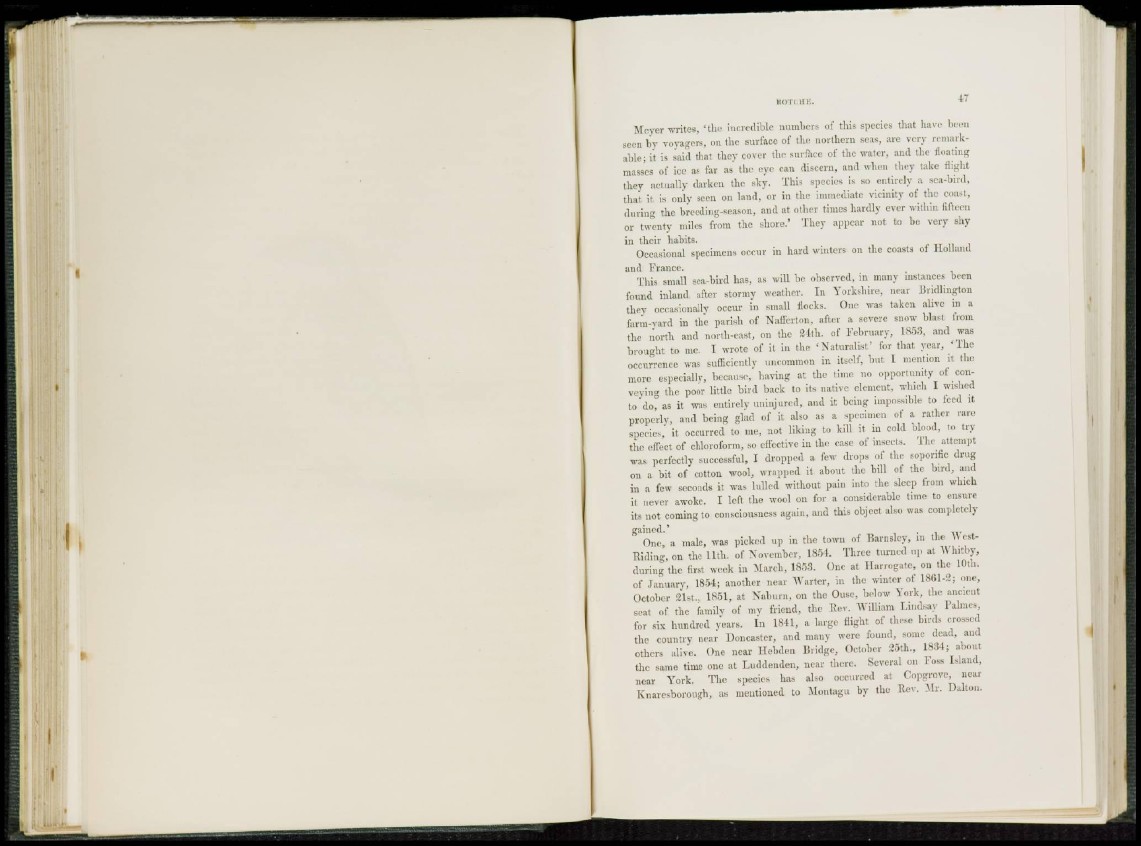
Meyer writes, ' t h e incredible numbers of this species that have been
seen b y voyagers, on the surface of the northern seas, are very remarkable;
it is said that they cover the surface of the water, and the floating
masses of ice as far as the eye can discern, and when they take flight
they actually darken the sky. This species is so entirely a sea-bird,
that it is only seen on land, or in the immediate vicinity of the coast,
during the breeding-season, and at other times hardly ever w itliiu fifteen
or twenty miles from the shore.' They appear not to be very shy
in their habits.
Occasional specimens occur in hard winters on the coasts of Holland
and France.
This small sea-bird has, as will be observed, in many instances been
found inland after stormy weather. In Yorkshire, near Bridlington
they occasionally occur in small flocks. One was taken alive in a
farm-yard in the parish of Nafferton, after a severe snow blast from
the north and north-east, on the 24th. of February, 1853, and was
brought to me. I wrote of it in the ' N a t u r a l i s t ' for that year, ' T he
occurrence was sufficiently UNCOMMON in itself, but 1 mention it the
more especially, because, having at the time no opportunity of conveying
the poor little bird back to its native clement, which I wished
to do, as it was entirely uninjured, and it being impossible to feed it
properly, and being glad of it also as a specimen of a rather rare
species, it occurred to me, not liking TO kill it in cold blood, to try
the effect of chloroform, so effective in the case of insects. The attempt
was perfectly successful, I dropped a few drops of the soporific drug
on a bit of cotton wool, wrapped it about the bill of the bird, and
in a few seconds it was lulled without pain into the sleep from which
it never awoke. I left the wool on for a considerable time to ensure
its not coming to consciousness again, and this object also was completely
gained.'
One, a male, was picked up in the town of Barnsley, in the \\ colliding,
on the 11th. of November, 1854. Three turned up at Whitby,
during the first week in March, 1853. One at Harrogate, on the 10th.
of January, 1854; another near Warter, in the winter of 1861-2; one,
October 21st., 1851, at Naburn, on the Ouse, below York, the ancient
seat of the family of my friend, the Rev. William Lindsay Palmes,
for six hundred years. In 1841, a large flight of these birds crossed
the country near Doncaster, and many were found, some dead, and
others alive. One near Hebden Bridge, October 25th., 1834; about
the same time one at Luddenden, near there. Several on I'nss Island,
near York. The species has also occurred at Copgrovc, near
Knarcsborough, as mentioned to Montagu by the He v. Mr. Dalton.